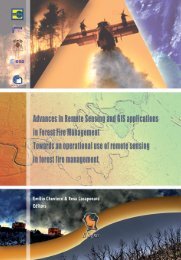Mapping microphytobenthos in the intertidal zone of Northern ...
Mapping microphytobenthos in the intertidal zone of Northern ...
Mapping microphytobenthos in the intertidal zone of Northern ...
You also want an ePaper? Increase the reach of your titles
YUMPU automatically turns print PDFs into web optimized ePapers that Google loves.
2.4.1. CASI data<br />
CASI overflights occurred <strong>in</strong> September 2000, under poor wea<strong>the</strong>r conditions (overcast skies), prevent<strong>in</strong>g<br />
concurrent atmospheric measurements. Field reflectance spectra were none<strong>the</strong>less acquired over four reference<br />
sites. Empirical atmospheric corrections were performed us<strong>in</strong>g <strong>the</strong> empirical l<strong>in</strong>e technique and two <strong>of</strong> <strong>the</strong> reference<br />
sites. Three flight l<strong>in</strong>es were necessary to cover <strong>the</strong> entire Bay but we tested <strong>the</strong> algorithms on a subscene<br />
correspond<strong>in</strong>g to <strong>the</strong> area were <strong>the</strong> reference sites were located and <strong>the</strong> bi<strong>of</strong>ilm was present.<br />
The CASI <strong>in</strong>strument was flown <strong>in</strong> a “MERIS like” configuration with an additional band centered at 673.9 nm to<br />
map Chl a. Table 1 summarizes <strong>the</strong> ma<strong>in</strong> characteristics <strong>of</strong> <strong>the</strong> CASI data.<br />
Table 1. Characteristics <strong>of</strong> CASI data<br />
2.4.2. ROSIS data<br />
Band # Central wavelength (nm) Band width (nm)<br />
1 411.9 14.0<br />
2 443.3 14.2<br />
3 489.8 14.2<br />
4 510.3 14.2<br />
5 560.1 12.4<br />
6 619.7 14.4<br />
7 665.4 10.6<br />
8 673.9 8.8<br />
9 681.9 8.8<br />
10 704.5 12.6<br />
11 733.2 10.6<br />
12 760.8 6.8<br />
13 776.1 18.4<br />
14 865.2 24.0<br />
Spatial resolution: 2 m<br />
ROSIS data were acquired <strong>in</strong> <strong>the</strong> framework <strong>of</strong> <strong>the</strong> 2001 HySens Campaign, <strong>in</strong> August 2001. The wea<strong>the</strong>r<br />
conditions were good, allow<strong>in</strong>g for concurrent atmospheric and reflectance measurements. Aerosol optical depth<br />
derived from atmospheric measurements was used by DLR <strong>in</strong> <strong>the</strong>ir atmospheric correction procedure. Data were<br />
also georeferenced us<strong>in</strong>g aircraft and ground GPS <strong>in</strong>formation. Field reference sites were spatially located us<strong>in</strong>g<br />
GPS.<br />
ROSIS is an airborne imag<strong>in</strong>g spectrometer, mak<strong>in</strong>g use <strong>of</strong> a two-dimensional CCD array for imag<strong>in</strong>g<br />
simultaneously 115 spectral bands <strong>of</strong> 512 picture elements perpendicular to <strong>the</strong> flight direction. The spatial<br />
resolution was 2 m, <strong>the</strong> spectral range 416.5 – 872.5 nm with a spectral sampl<strong>in</strong>g <strong>in</strong>terval <strong>of</strong> 4 nm.<br />
The data appeared fairly noisy so additional preprocess<strong>in</strong>g was necessary. MNF transform was performed to<br />
remove most <strong>of</strong> <strong>the</strong> noise, <strong>the</strong> first 5 channels were removed and a reference site (dry sand) was used to ref<strong>in</strong>e<br />
atmospheric corrections.<br />
3. RESULTS<br />
3.1. Field reflectance spectra<br />
Results for <strong>the</strong> regression <strong>of</strong> simple ratio, normalized ratio and scaled band area versus field samples Chl a<br />
concentration are presented <strong>in</strong> Figure 3. The dependency <strong>of</strong> absorption depth (simple ratio) or normalized<br />
absorption depth (normalized ratio) to Chl a concentration can be approximated by an exponential function fit<br />
(Beer-Lambert-like law) (Figure 4a and b). The functional relationship between scaled band area and Chl a<br />
concentration was assumed a l<strong>in</strong>ear function (Figure 4c).<br />
400
















